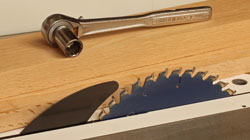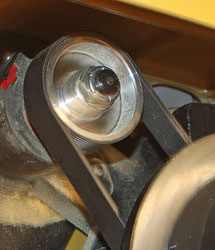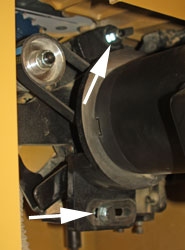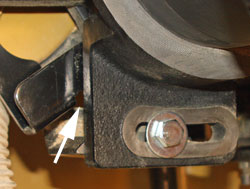This is a Veteran Owned site
![]()
 |
Despite the supposedly "informed" assertions about a weak motor, tightening the drive belt cures nearly all of those symptoms. Click image to enlarge |
POWERMATIC PM2000 Belt Slippage
An easy fix for a stubborn bit of Internet hysteria
Text, photos and video by Tom Hintz
Posted - 7-11-2008
NOTE: Unplug the saw from the power source before making any adjustments!
The Internet is a great place to exchange information. Unfortunately, it is equally efficient at disseminating half-truths and outright bogus information. In too many cases, people believe whatever they read on a forum and check their common sense at the data port somewhere. In the case of the POWERMATIC PM2000 table saw, comments by a few under-informed "forum wizards" spread word of a problem on the POWERMATIC PM2000 that didn't exist then and doesn't exist now.
The sad part is that this misinformation caused some owners of this world class saw to be disappointed in its performance and others not to buy it in the first place based on information that simply is not true in most instances. In one case I personally know of, a disillusioned owner actually sold a perfectly good POWERMATIC PM2000 because the "forum experts" assured him that "everybody knew" that the motor was hopelessly under powered and/or defective and/or poorly designed. The "facts" they offered seemed to wander some from forum to forum. As we will see, and this previous owner found out (later) to his dismay, the truth is very different and way less complicated.
Now I know full well that any manufacturer will put out a dud motor occasionally and that POWERMATIC is not immune. However, the frequency at which bad motors make it to market is far less than the aforementioned "experts" suggest. So far, I have not encountered a single motor that was actually bad. We have found a few not-quite-tight belts though.
 |
A couple traits of the Poly-V belt contribute to the confusion. It often does not squeal, smell or give other indications that it is slipping. |
Poly-V Belt
The POWERMATIC PM2000 uses a Poly-V belt (serpentine style) belt to transfer motor power to the blade. The Poly-V belt is used because it is very efficient at delivering power and has a long life. Because the Ploy-V belt is very thin, it generates far less heat at its edges. The much thicker sides of a traditional V-belt have far more heat-building friction at the sides where it rubs on the sides of the deep pulley grooves. That heat buildup could damage arbor bearings and shorten the life of the belt itself.
What many people do not know about a Poly-V belt is that it also runs very quietly, including when it slips. A Poly-V belt typically does not squeal when it slips. Because it runs cooler it is far less likely to create an odor when it slips. A V-belt almost always emits a "hot" or "burning" smell because of its much larger friction points at the pulleys.
It is this lack of sound or smell "signals" from the Poly-V belt that seems to fake people out and inadvertently lend credibility to the claims that the motor is the culprit. The woodworker senses the blade slowing or stalling during a cut but does not smell or hear anything from the belt so when someone points to the motor, that can sound logical.
The Fix
 |
 |
Open the side door and the motor mount (left) and its pivots (arrows) are easily accessible. Lower the blade all the way and a notch (right, arrow) comes into view that can be used with a large screwdriver to gain a little leverage on the motor mount. Click images to enlarge |
|
Correcting this problem on the POWERMATIC PM2000 is very simple and takes just a few minutes. The POWERMATIC PM2000 instruction manual covers the belt tensioning procedure very well. The trunion assembly to which the motor is attached puts the belt tensioning mechanism within easy reach through the large door on the side of the cabinet. In addition to being easy to do, the lack of stretch in a Poly-V belt means you are not likely to have to repeat the process very often.
It is important to remember that the difference between a "loose" Poly-V belt and a properly tightened one is nearly impossible to see. In every case I have come across, we simply tightened the belt a little more than it was and the slippage problem disappeared. Most times the amount of movement of the motor mount was approximately 1/4". I would suggest that as a starting point and then adding 1/8" adjustments if necessary. This is an easy adjustment to make so there is no reason to hurry or take chances.
See the video on this page for a closer look at the adjusting mechanism. There is a notch in an associated bracket (lower the blade all the way) that allows using a large screwdriver or small bar to gain a little leverage to move the motor mount. You don't have to lean on the bar. This is just an easier way to move the mount a little bit and hold it steady while tightening the locking bolt.
Common Sense
Video Tutor |
Even I am not optimistic enough to think adjusting the Poly-V belt will fix this type of problem in all POWERMATIC PM2000 table saws. However, if my experience over the last couple of years is any indication, this simple belt adjustment will be the answer way more than new motors will. OK. Except in the adjustable reality of cyberland maybe....
If tightening the belt does not fix the problem it is time to check the electrical service powering the POWERMATIC PM2000 and then call POWERMATIC. My guess is very few (if any) of you will have to go that route.
Visit the POWERMATIC web site - Click Here
Have a comment on this story? - Email Me!
Back to the Tips & Tricks List
All written, photographic and drawn materials are property of and copyright by NewWoodworker.com LLC 2000-2019. Materials may not be used in any way without the written permission of the owner.
